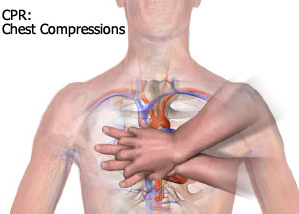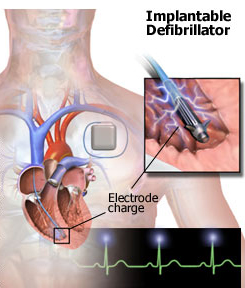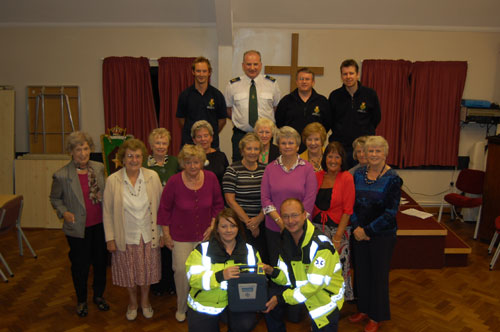An automated external defibrillator (AED) is a type of defibrillator that detects the electrical activity in the heart and gives automated instructions to the medic on what to do.
Shocking the heart, or electrical defibrillation to use its technical name, is well-established as the only effective therapy for cardiac arrest due to ventricular fibrillation (VF) or pulseless ventricular tachycardia (VT). The scientific evidence to support early defibrillation is overwhelming, the single most important determining factor for survival being the time between collapse to delivery of the first shock. During this period, basic life support helps to sustain a shockable rhythm, but is not a definitive treatment
Strongly supported by the Resuscitation Council (UK), early implementation of defibrillation has become something that members of the public, with the appropriate training, can perform safely and effectively, due to recent developments in automated external defibrillators (AEDs).
Using An AED
The automatic external defibrillator (AED) operator needs to do only four things:
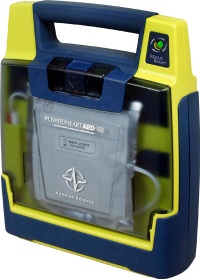 |
Turn on the AED Attach the pads to the patient's chest Follow the instructions on the AED readout Keep bystanders away from the patient (to minimize the risk of accidentally shocking someone). The AED reads the patient's heart rhythms to determine if a treatable rhythm? exists. In general, 80 percent of rhythms occurring at the moment of collapse are treatable, but this is less likely as more time passes. If the patient does not have a treatable rhythm, the AED will not discharge the electrical shock. |
|---|
What Does An AED Do?
A defibrillator is a device that attempts to restore a normal heart rhythm by delivering an electrical shock to the heart. A defibrillator is used when the heartbeat is dangerously fast due to ventricular tachycardia or ventricular fibrillation. Either of these conditions can be life-threatening because the heart may abruptly stop pumping blood to the body (cardiac arrest). Some defibrillators are external (e.g., defibrillator paddles in an emergency room), and some are surgically implanted in the patient?s chest (e.g., an implantable defibrillator cardioverter).
Recent advances in technology have allowed people with little training to use automatic external defibrillators (AEDs) in an emergency when medical professionals are not present. Studies have shown that use of public access defibrillators (PAD) within moments of collapse significantly raises the survival rate from cardiac arrest, with between 50 percent and 74 percent of victims surviving their collapse. Based on these studies, the American Heart Association has endorsed the use of PADs.
Automatic external defibrillators (AEDs) are external devices that can be used by minimally trained laypersons in emergency situations. They not only administer an electrical shock in order to restart the heart, but also read the patient's heart rhythm patterns. This significantly reduces the amount of training needed for their effective use and allows people with minimal training to perform defibrillation in emergency situations with little risk of additional injury to the patient. One study that looked at the usefulness of putting AEDs in Chicago airports found that people were able to revive cardiac arrest patients by using nearby defibrillators, even though they had no training in how to use them.
| Automatic defibrillation attempts should begin as quickly as possible. For every minute that passes without defibrillation, a victims chance of survival decreases by 7 percent to 10 percent. If the heart does not return to a regular rhythm within five to seven minutes of the onset of cardiac arrest, the result could be fatal. This is why groups such as the American Association Heart and the National Institute Blood and Lung, Heart, advocate the widespread availability and use of AEDs. Indeed, AEDs have become more common in ambulances and fire rescue vehicles, as well as in places that are cut off from traditional emergency assistance, such as airplanes. | 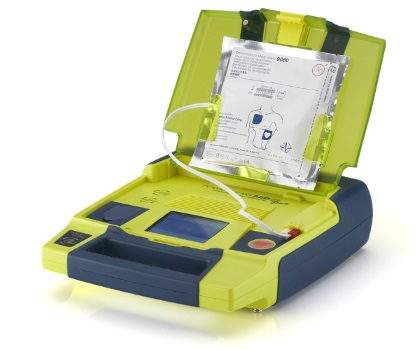 |
|---|
In fact, all U.S. airlines are now required to carry AEDs on all domestic and international flights.
AEDs are also appearing in increasing numbers of public places, such as stadiums, casinos, shopping malls, health clubs and golf courses. Programs are even appearing in local schools to train students in both cardiopulmonary resuscitation (CPR) and in the use of AEDs. According to studies, correct use of AEDs can raise the survival rate of victims of cardiac arrest to between 50 percent and 75 percent.
Frequently Asked Questions
Q Is there a minimum age for receiving training in the use of this equipment, bearing in mind that the age for a junior diver within BSAC is 12yrs old ?
A The minimum age for doing the course is 12 years old. The standard equipment can be used on casualties as young as 8 years old.
Q Are all makes and models of AED the same and does the course train you to use any model of AED ?
A All AEDs work in a very similar way and the ones that are suitable for use in the diving environment are not special in this respect, they are just the most waterproof and robust of those available. The Course will train you to use any AED.
Q Can anyone buy an automated external defibrillator (AED)?
A Anyone is able to buy an AED regardless of whether they have done a course or not, however the BSAC course gives important information about choosing a machine for use in diving which many other courses do not include. This will help anyone thinking of buying a machine choose one that is suitable for where they plan to use it.
Q Can you harm someone by giving a shock when they do not need it?
A If someone is given a shock by a defibrillator when they do not need it, it can be potentially lethal by causing the heart to stop. However the sophisticated electronics of an AED make it impossible to give a shock if it is not needed and may be harmful.
Q Can an AED make mistakes?
A No equipment is infallible, however AEDs have very sophisticated software and if the machine is used properly it is unlikely that such mistakes could make the condition of a casualty any worse.
Q What if I'm not certain whether or not I need to use an AED?
A The training course will explain when an AED should be used. Basically any casualty who is unresponsive and not breathing normally should have the pads of an AED applied as soon as possible. The machine will then indicate whether it is necessary to administer a shock.
AED Vs CPR
Both the automatic external defibrillators (AED) and CPR (cardiopulmonary resuscitation) are techniques that can be used in emergencies when someone has gone into cardiac arrest – an often fatal condition in which the person loses consciousness as a result of the heart abruptly ceasing to pump blood to the body.
| Although CPR is a vital life-sustaining tool, it cannot restore the patients heart rhythm. Defibrillation can. Research has consistently demonstrated that early defibrillation (within three to five minutes) greatly increases the survival rate of patients in cardiac arrest. Without defibrillation, however, each passing minute decreases the chance for survival by an additional 10 percent. |
|
|---|---|
To help clarify when the AED is appropriate, the American Heart Association has endorsed a sequence of events to be used if someone collapses of cardiac causes. Before the AED is used, bystanders should contact emergency personnel and attempt CPR. If no signs of circulation are present after CPR and an AED is available, it should be attempted. |
|
| Other Types Of AEDs | |
| Manual Defibrillators | ||||
|---|---|---|---|---|
| Implantable cardioverter defibrillators | ||||
|
Manual defibrillators or defibrillator paddles are typically used by physicians in the emergency room. Many popular television programs demonstrate emergency personnel shouting "Clear!" before using the defibrillator paddles. This is done because people touching the person about to receive the shock may receive a shock themselves. Manual defibrillators are also used in non–emergency situations in a procedure called elective cardioversion. In this procedure, shocks are used electively to restore normal heart patterns in patients with non-emergency arrhythmias (e.g., atrial fibrillation). |
|||
In contrast with manual defibrillators, implantable cardioverter defibrillators (ICDs) are surgically implanted in peoples chests. ICDs are similar in many respects to pacemakers, which also correct an abnormal heart rhythm. However, pacemakers are usually chosen to correct a heart rhythm that is too slow (bradycardia), whereas ICDs are commonly used to detect and correct a heart rhythm that is too fast (tachycardia). In potentially fatal cases, the ICD can deliver an electric shock (defibrillation) to reset the heartbeat. Pacemakers cannot deliver the high energy electrical shock required for defibrillation. How Can You Help Us? Become A Volunteer Become A Member If you are a school, a college, a meeting place, then you could organise an event for us. Do a sponsored event Send us a donation Please help us to provide this essential equipment. Contact us and see how you can help us to provide these life saving machines.
Donating To 1st Responders |
||||













